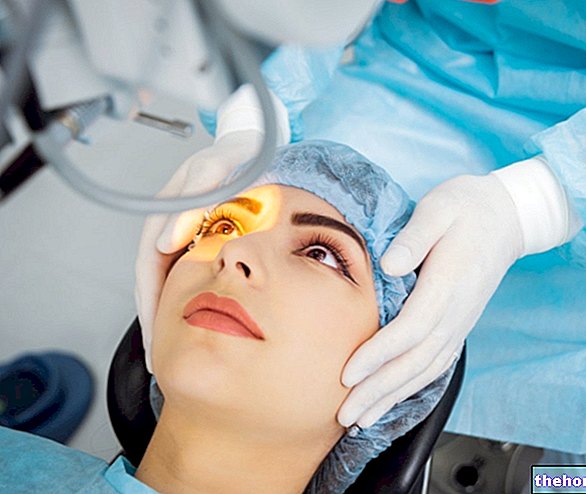Generality
Artificial tears are sterile solutions, based on viscous substances, capable of retaining moisture on the surface of the eye; they are available in the form of eye drops, gels and ointments, which simulate the natural composition of tears.

Natural tears
Tears are essential for keeping the eye healthy. The tear film lubricates the ocular surface, reduces friction, supplies nourishment and oxygen to the conjunctival epithelium and protects the eyes from any small foreign bodies, toxic substances and bacteria.
Tears are made up of water, carbohydrates, lipids, electrolytes, lysozymes (enzymes with bactericidal activity), lactoferrin (a protein that prevents or slows bacterial growth) and binding proteins.
The tear film of the eye (or precorneal film) has three distinct layers, from the outermost:
- Lipid layer: composed of fats, it is secreted by the meibomian glands. Coats the aqueous layer; provides a hydrophobic barrier to prevent the tear film from exiting the eye and helps maintain the hydration of the ocular surface.
- Aqueous layer: secreted by the tear glands, it is composed of water and other substances such as electrolytes, organic acids, amino acids and proteins. Reduces the friction of eye and eyelid movements; promotes tear film diffusion, control of infectious agents and osmotic regulation.
- Mucous layer: it is secreted by the goblet cells of the conjunctiva and covers the cornea; making the surface hydrophilic, otherwise hydrophobic.
The altered composition of the tear film and the lack of or poor production of tears can have several consequences, including serious corneal damage.
Artificial Tears and Dry Eyes
Artificial tears help replenish and stabilize the tear film that covers the eye, soothing the irritation and discomfort caused by keratoconjunctivitis sicca (dry eye). When applied at regular intervals, artificial tears can generally control the problem in people who are not producing enough tears or when the tear film is unstable. Severe cases require more aggressive treatment, such as instillation of artificial tears 10-12 times a day. Once symptoms improve, the product can be used as needed, approximately three or four times a day. For moderate or severe dry eye, artificial tears can be supplemented with other therapies.
Composition and pharmaceutical forms
Although it is impossible that artificial tears can perfectly replace their natural counterpart, the available products try to simulate the composition of at least one of the three layers of the tear film. Artificial tears are formulated based on water, salts and polymers, but do not contain the proteins found in natural ones. The products may contain carboxymethylcellulose, hydroxypropylmethylcellulose (HPMC or hypromellose), hydroxypropylcellulose and hyaluronic acid. Hydroxypropylcellulose and other thickening agents stabilize and thicken in the precorneal tear film, prolonging the time the solution stays on the ocular surface. In addition to lubricating the eyes, some artificial tears contain electrolytes. These additives can promote cell healing on the surface. of the eye.
Another important approach to formulating an excellent product is to attempt to mimic the biphasic nature of tears by providing a lipid and aqueous component, where the lipid substitute stabilizes the tear film better.
Another factor to consider is viscosity. Patients with mild dry eye may prefer an aqueous solution, while those with severe dry eye may prefer a more viscous preparation, which stays on the cornea longer, decreases friction and lubricates more. The main side effect of gels and ointments is the temporary blurry vision.
Another element of differentiation between the drops is osmolarity. If this parameter is lower, some artificial tears may have a better effect on the ocular surface. The ingredients that allow to obtain a lower osmolarity are called osmoprotectants (example: L-carnitine and erythritol). These are absorbed by the epithelial cells on the surface of the eye and dampen their response, preventing cell damage from hyperosmolarity.
Furthermore, it is possible to distinguish two categories of artificial tears:
- With preservatives. These artificial tears are often available in multi-dose bottles and contain chemicals (preservatives) that discourage the growth of bacteria once the package has been opened. However, preservatives can irritate the eyes, especially in cases of moderate or severe dry eyes.
- Preservative free. These artificial tears have fewer additives and are generally recommended if you apply them more than four times a day or if you have moderate or severe dry eye. Often, preservative-free products are available in single-dose vials.
As anticipated, lubricating ointments may offer longer-lasting relief than eye drops, but they can cause temporary blurred vision. For this reason, such products should be applied just before bedtime.
Artificial tears are available without a prescription, but it is useful to consult your eye doctor to decide the best approach for your specific case, especially based on the origin and extent of the condition. There are numerous products, with different ingredients and, sometimes, this wide choice on the market is a source of confusion for the patient.
To select the product, it is important to consider:
- The underlying cause of dry eye (example: tear production deficiency or systemic disease);
- How often the patient is applying artificial tears: based on the severity of the disease and the dosage, is a product with or without preservatives more appropriate?
Note: Some types of artificial tears contain preservatives such as benzalkonium chloride, which can produce toxic or hypersensitive effects.The instillation of drops containing benzalkonium chloride for long periods of time could damage the front of the eye (ie it can cause corneal toxicity, inflammation and reduced tear production). Therefore, if you use artificial tears more than four times a day, in the long term, it is better to use a product without preservatives or that does not contain, in particular, this preservative.
Types of artificial tears
Artificial tears designed to relieve dry eye symptoms are mainly:
- Artificial tears with cellulose derivatives: add viscosity to the fluid on the surface of the eye, helping to temporarily relieve the symptoms of dry eye.
- Artificial tears based on glycerin: thanks to the water content, they help to keep the eye moist.
- Tears containing hyaluronic acid: hyaluronic acid gives the product characteristics similar to artificial tears based on cellulose derivatives.
- Tears with polyethylene glycol and propylene glycol: they have a lower viscosity than cellulose-based products and create a protective layer to allow damaged areas of the cornea to heal.
- Oil-based tears: contain oil (for example: mineral oil) and other ingredients in emulsion, which aim to stabilize the tear film. The oily part of the natural tear film may be deficient if conditions such as blepharitis or meibomian gland dysfunction are present.









.jpg)


















